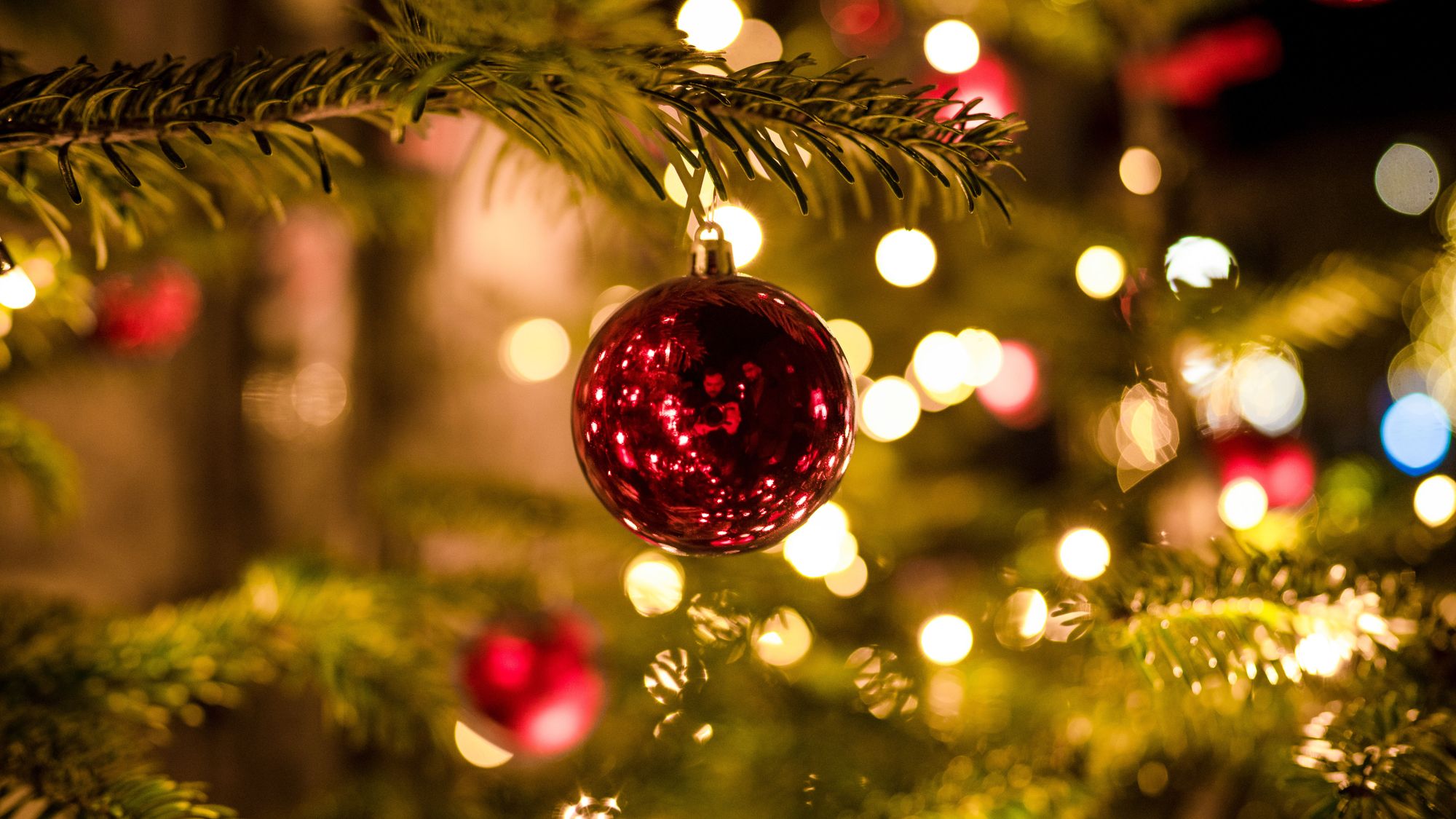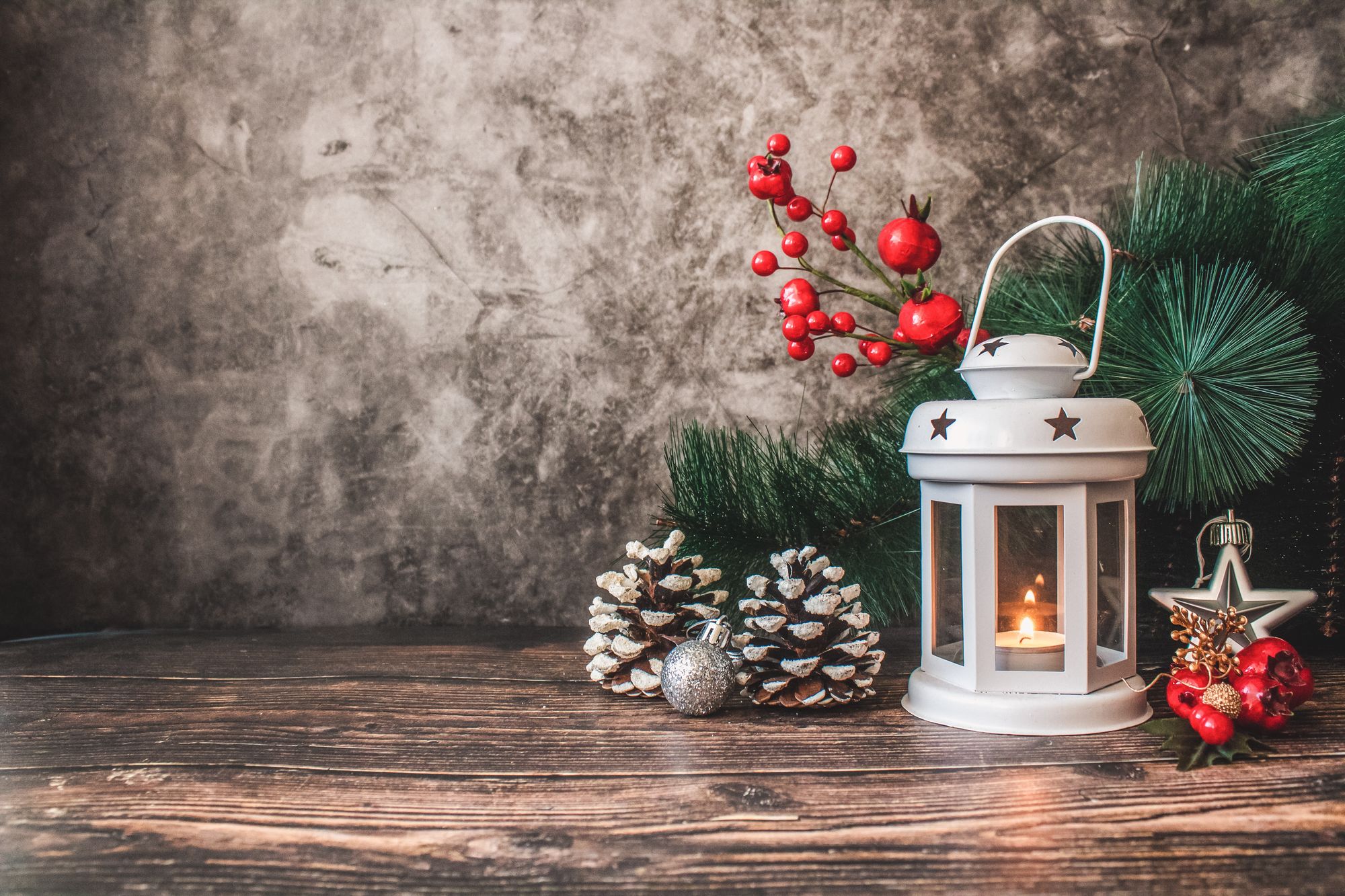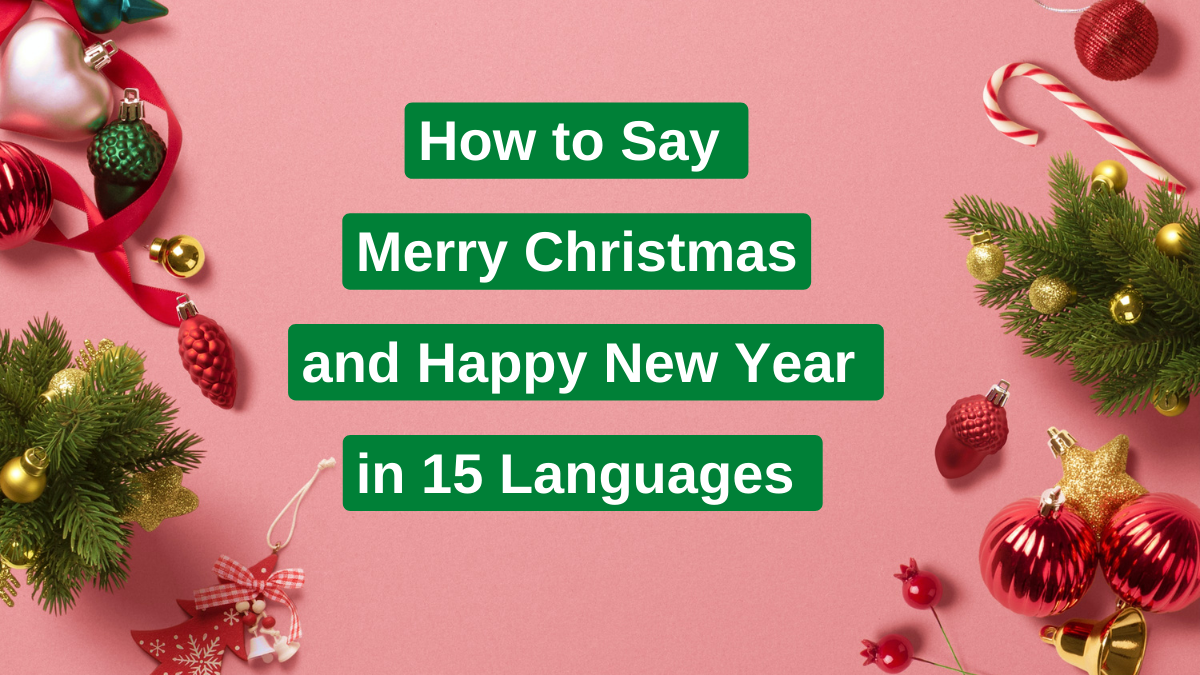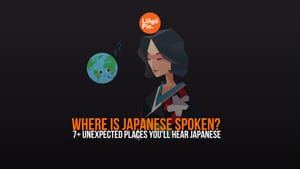It's that time of year again! Regardless of where you are in the world and what season it is there, that joyful Christmas feeling is in the air!
Whether you're planning a festive trip, or want to wish your overseas friends a happy holiday season, we've got you covered.
Read on to learn how to wish someone a merry Christmas and a happy New Year in (1) Spanish, (2) Portuguese, (3) Italian, (4) French, (5) German, (6) Dutch, (7) Croatian, (8) Russian, (9) Norwegian, (10) Danish, (11) Finnish, (12) Tagalog, (13) Japanese, (14) Korean and (15) Chinese.
We will also look at Christmas and New Year’s customs and traditions in various countries.
See also: Five Non-Traditional Gift Ideas For Christmas
Christmas Around the World
Every country has its own beliefs, traditions and customs around the holiday season, and we will briefly explore these differences for each of the 15 different languages we have chosen.

English and "X-Mas"
Historically, Christians have used “X” to represent Christ. This comes from the Greek letter Chi, or “X”, which is the first letter in the Greek word for Christ, Christos (Χ ΡΙΣΤΟΣ).
The “mas” in Christmas comes from the Old English word for “mass”. The two words together make “Christ's mass” or Christmas.
It's worth noting that over the years this phrase has largely lost its original meaning and is now used more commonly as a general festive greeting by religious and non-religious English speakers alike.
Saying Merry Christmas and Happy New Year in 15 Languages
Spanish
In Spanish, "merry Christmas" is Feliz Navidad, which you might recognize from the great holiday song of the same name.
There are a lot of traditions around Christmas, such as a feast and midnight mass on Christmas Eve, or la Nochebuena. Spaniards have a smaller feast on Christmas Day, which is when kids will find out what Santa Claus, or Papá Noel, has brought them.
For "happy New Year", you can say feliz año nuevo, or que tengas un próspero año, "I hope that you have a prosperous new year". New Year's Eve is La Nochevieja.
In many European countries, including Spain, the 6th of January is one of the most significant days of the festive period. This is the Día de Reyes, or the Day of Kings, in which the three Magi, Melchior, Gaspar, and Balthazar, deliver gifts. Most cities and towns will hold parades.
Portuguese
Portuguese for "merry Christmas" is feliz natal. Like in Spain, Portuguese families will gather for a big meal on the 24th (a véspera do Natal) and a smaller family lunch on Christmas Day.
Christmas dinner is called Consoada and it consists of boiled cod, potatoes, eggs, and cabbage with hot olive oil sauce, garlic and vinegar on the side.
Midnight mass is also traditional in Portugal, though, in recent years, attendance has diminished. More likely now is that families will exchange gifts at midnight.
January 6th, Epiphany, is also celebrated in Portugal, mainly at home with family. As a tourist, you might not notice much except that shops are shut on this holiday.
"Happy New Year" is feliz Ano Novo, and "New Year's Eve" is véspera de Ano Novo.
Italian
Some people in northern Italy kick off their festive celebrations on December 13th with Santa Lucia. According to tradition, Saint Lucia was a martyr who fed persecuted Christians. Her death is commemorated with gift-giving.
The Italian for "merry Christmas" is buon natale. Christmas dinner is eaten on Christmas Eve, known as vigilia di Natale, and varies depending on the region. Some Italians eat lasagne, while others opt for fish or tortellini.
New Year's Eve in Italy is also known as St Sylvester’s Feast (La Festa di San Silvestro). On this evening, Italians eat the cenone di Capodanno, or the New Year's Eve dinner, which is typically a traditional sausage, mashed potatoes and lentils.
January 6th is observed in Italy as well, but with a witchy twist! According to Italian lore, Befana, an old witch on a broom with a pointed hat, was asked by the Magi to take gifts to Bethlehem for Jesus' birth.
Initially, Befana refused, but when she had a change of heart, she decided to leave gifts for all of the children. Now, Italian kids wait eagerly for presents from Befana every January 6th.

French
Like in the above-listed countries, French Christmas begins with a feast on Christmas Eve known as Le Réveillon. This meal is supposed to last hours and go on until morning. Popular dishes include duck rillettes, foie gras, oysters, and snails.
Midnight mass is observed in France too, though many people opt to attend daytime mass on Christmas Day instead. Kids typically open their presents from Père Noël, "Father Christmas", on Christmas Day.
It is bad luck to wish anyone a Bonne Année, or "Happy New Year", before midnight on New Year's Eve.
Similar to traditions in Spain and Portugal, France celebrates Epiphany on January 6th with various customs, including a cake called la galette des rois, "the cake of kings". A figure is hidden inside the almond cream of the cake, and whoever finds it gets good luck.
And, of course, in French, "merry Christmas" is Joyeux noël !
German
In German, frohe Weihnachten means "merry Christmas". Christmas Eve is not the main day of celebration, but many people will eat a traditional potato salad with sausages in the evening.
Families gather on December 25th to eat roast goose or duck stuffed with apples, chestnuts, prunes, red cabbage, boiled potatoes, and dumplings.
In southern Germany, it is traditional to visit a friend and praise their Christmas tree on the 26th of December. This is called Christbaumloben, and the praise should be rewarded with several glasses of schnaps!
"Happy New Year" is Frohes neues Jahr!
Dutch
Christmas begins early in the Netherlands on December 6th, when Sinterklaas, "Santa Claus", arrives in the country and starts handing out presents. Yes - Dutch kids can expect a Christmas present as early as December 6th!
"Merry Christmas" is Prettige Kerstdagen in Dutch. Unlike many of the other European countries listed, Christmas Eve is largely ignored in the Netherlands. Instead, like in Germany, the 25th and 26th of December are the days to gather with friends and family and eat a lot.
Dutch Christmas food and drink include mulled wine and oliebollen, fried fluffy pancakes served with powdered sugar.
To wish someone a happy New Year, you say gelukkig nieuwjaar!
Croatian
Greet your Croatian friends with a Sretan Božić ("merry Christmas") this festive period.
Like Italy, Croatia also observes St Lucia's day, and children will receive gifts to mark the occasion. Then, on Christmas Eve, families gather to decorate the Christmas tree and prepare for the 25th.
On Christmas Day, children open presents and a family breakfast is shared. Then, families go to mass. The dinner consists of roasted turkey, duck or goose, and sarma (cabbage rolls filled with rice and minced pork). Makovnjača, or poppy seed rolls, are staples in Croatia at Christmas.
Sretna nova godina is "happy New Year" in Croatian.
Russian
In Russian, s novym godom is Happy New Year. We mention this first because, in Russia, this comes before Christmas!
Russians celebrate Christmas on January 7th because the Russian Orthodox Church adheres to the Julian Calendar. Christmas Eve, which is January 6th, is marked by church services.
"Merry Christmas" is s rozhdestvom. Russians will cover their floors and tables with hay to represent Jesus's manger and traditionally eat porridge.
Norwegian
In Norway, "merry Christmas" is God Jul. On Christmas Eve, gifts are brought by Julenissen (Santa) and gnomes called Nisse. Some Norwegians will leave out porridge for the gnomes.
People also eat porridge on Christmas Eve and mutton with cabbage on Christmas Day. Carolers will go door to door dressed as characters from the Biblical Christmas Story. A classic Christmas carol in Norway is "O Jul med din Glede", which means "oh Christmas with your joy".
You can wish someone a happy New Year in their native language in Norway by saying godt nytt år.

Danish
In Denmark, Glædelig Jul means "Happy Christmas". You might notice this is similar to the Norwegian. Moreover, "Happy New Year" is Godt nytår, which also bares a close resemblance.
In Denmark, Santa is called the Julemanden, or "Christmas man", and he brings presents on Christmas Eve, helped by the Nisse gnomes.
Presents are opened on Christmas Eve, and the big meal is consumed that evening. This often involves roast pork and duck, boiled potatoes, red cabbage, and gravy.
Finnish
Finnish is one of the oldest European languages. To wish a Finnish person a "Happy Christmas" in their own language, you would say Hauskaa joulua.
Christmas Eve is the main day of celebration in Finland, and roast ham and casserole are traditional dishes. Some Finnish people choose to decorate a tree in the garden or nearby woods instead of buying one, to preserve nature.
Hyvää uutta vuotta is "Happy New Year" in Finnish.
Tagalog
The Philippines celebrates the world's longest Christmas period. Carols are sung from September until Epiphany. "Merry Christmas" is Maligayang pasko.
Dawn masses are attended between the 16th and 24th of December, and at midnight on Christmas eve, people gather with their loved ones for a feast. The dishes include cheese, noodles, fruit salad, and Christmas ham.
"Happy New Year" in Tagalog is manigong bagong taon.
Japanese
In Japanese, Christmas and New Year are celebrated in the opposite fashion to Western countries. Christmas is a time for couples and friends to get together and party, while New Year is to be spent with family, eating, exchanging gifts, and visiting the temple.
In fact, Christmas Eve is like Valentine's Day in Japan, and most people will want to have a date for the occasion. "Merry Christmas" in Japanese is Meri Kurisumasu.
Once the New Year has begun, you can wish someone a "Happy New Year", or ake mashi te omedetou.
Korean
"Merry Christmas" in Korean is 메리 크리스마스 (Meri Keuliseumaseu). Like in Japan, Christmas is more for couples and friends, while New Year is a family affair.
"Grandpa Santa", or Santa Harabujee, brings presents on Christmas Eve and generally Koreans will receive one or two presents, not a whole pile. Most people will attend mass on Christmas Eve or Christmas day.
Wish your Korean friends a "Happy New Year" by saying saehae bock manhi batseyo.
Chinese
Wish your Chinese friends a happy Christmas by saying shèng dàn kuài lè.
In China, Christmas is not so much a Christian holiday - in fact, it is not a holiday at all. Instead, shopping is encouraged to boost the economy and young couples treat it as Valentine's day.
Chinese New Year relates to the Lunar calendar and normally falls between January 20th and February 21st. Each year is represented by an animal, of which there are 12. Everyone has a Chinese zodiac sign.
Wish someone a Happy Chinese New Year by saying gong hei fat choy.
FAQs: How to Say Merry Christmas in Multiple Languages
How do you say merry Christmas in different languages around the world?
It would be impossible to list the ways to say "Merry Christmas" in all of the different languages in the world, but here is a brief list of fun ones you probably haven't heard before.
Indonesian: selamat hari natal/ selamat natal, Mongolian: zul saryn mend (Зул сарын мэнд), Greenlandic: juullisiorluarit, Haitian Creole: Jwaye Nowèl, Hawaiian: Mele Kalikimaka, Serbian: Hristos se rodi, Swahili: Krismasi njema, Zulu: Ukhisimusi omuhle, and Yoruba: e ku odun.
How do you say "Christmas lights" in different languages?
Nothing says happiness and festivities quite like "Christmas lights"! In Spain, these are called luces de Navidad, while in France they are lumières de Noël. In Italy, they say luci di Natale and in Portugal, luzes de Natal. Do you notice the similarities? You can learn one Romance language and it opens the doors to learning all of the others more easily!
In German, Christmas lights are Weihnachtsbeleuchtung! If this makes sense to you, why not add learning German to your list of New Year's resolutions?

Summing Up: How to Say Merry Christmas and Happy New Year in 15 Languages
Hopefully, this guide to saying merry Christmas in different languages has put you in the Christmas spirit.
We’ve looked at how Christmas and New Year are observed by different cultures around the world. Moreover, you have learned how to wish someone a "merry Christmas" in 15+ languages!
If you want to know more about Christmas traditions check out the video below:
If you've enjoyed expanding your horizons and learning these useful phrases in foreign languages, check out Lingopie. This streaming service is a great resource for developing your practical vocabulary in 8 popular languages.
Start learning Spanish, French, Portuguese, Italian, German, Russian, Korean or Japanese today. Watch great TV and movies in your target language and get immersed in the vocab, culture, and customs.








![How To Learn English With Sitcoms: 5 Easy Ways [Guide]](/blog/content/images/size/w300/2023/09/94E050B7-BD8B-4659-B6E5-B5996E461FC8.png)
